Stolen moments
2022
We all watch and are being watched. A fleeting stream of images pass by as we live our daily life. Our craving for the new visuals seems to be insatiable. So much so that it constrains our engagement with what we actually see. This installation with painted security images from CCTV cameras on the wall and monitors with painted ‘frozen images’ from the media on the ground stills the viewer for a moment to contemplate.

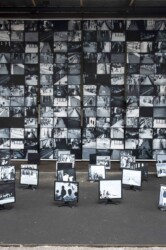

Mirror Mirror
2021
In the installation ‘Mirror-Mirror’ people are reduced to unguarded, vulnerable details. Small fragments of garment, gesture and posture determine the emotional meaning. At the same time, the mirrors might also suddenly show a glimpse of the visitors themselves or of the other people present. The viewer is as much voyeur as they are one of the ‘objects’.
Windows on paper Installation
2020
I have turned my constant struggle with the question, how legitimate it is to create similar / realistic work based on photos, into an installation.
In my studio I covered a wall with insulating foil with an aluminum top layer. For the installation I take a piece of that “silver wall” to the exhibition space. A number of oil paintings from the series “Windows on paper” are hung on that wall, together with the “source material”: intimate stills from film recordings of my neighbors. I edit all these film stills and make several prints of them in search of the right moment, the strongest image. A little to the right, a little to the left, a little bit bigger, a little bit smaller, maybe more zoomed in, or maybe just the next “frame”. I use all these prints as sketches and together they show my thinking and working method. That’s how I get to my paintings.
In the installation “Windows” this whole process itself becomes the subject. Everything is painted on the “silver wall”. From the works to the source material, even the remaining stains from previous projects.

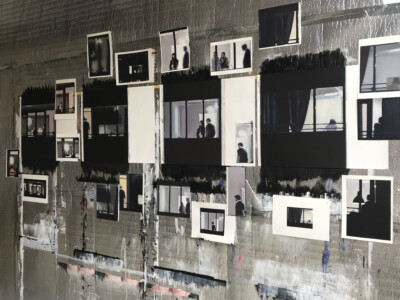

Body Bags
2019
The Installation ‘Body bags’ confronts us with the devastation of war. The dead salvaged on either side, the counting of the lives lost. The work shows this last ritual arrangement in black and in white; both colours of mourning. The two sides shown in the work mirror each other. By doing so they show the shared character of loss. In war parties are opposed to each other but they share this last space. By drawing attention to this, I challenge the viewer to rethink the relationship between the perpetrator and the victim.
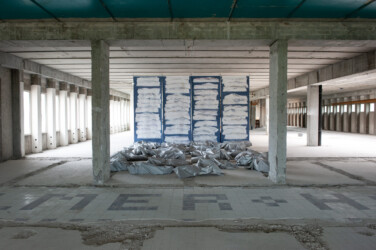
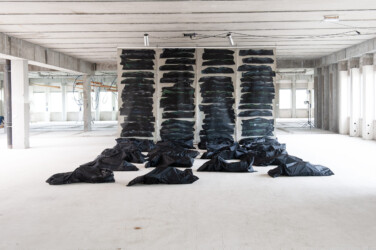

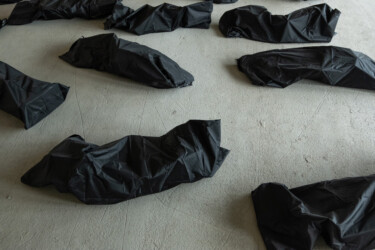
360 children
2019
Where did all those bodies come from?
In the work ‘360 Children’ I investigate the notion that children are the future. Whilst this association usually carries a hopeful tone, this work –which stands directly in conversation with ’Body Bags’– makes the radical suggestion of neutrality. What would it mean to truly open up to all possibilities that might lie in the future of the children? After examining the silence that followed violence, this work depicts the bodies for whom violence has not yet taken place.
In Transit
2019
A series of paintings in a line along a wall, each provided with subtitles. The linear relationship between the pieces and the addition of text creates an illusion of explanation and connection. An image follows an image and a text generates an understanding of what it is we see.
In the series ‘In Transit’ I question the instinct to have our gaze be guided by text. What if two different images have the same subtitle? What happens with the hierarchy of signification (in which text stands above image) if the text itself is painted?
Wunderbaum Installation
2019
In “Wunderbaum: Installation” I delve deeper into my research about the cliché by looking at how our experience of it changes by placing it elsewhere. After all, the familiar images are present everywhere, but they do not always have the same meaning.
A wall with a large amount of the ‘little trees’ gives the impression that it is possible for these works to stand outside of space and history; they are, as it were, still packaged on a shelf. However, the cheerful colors of the individual paintings and the relaxing effect of their clichéd images do not guarantee the spatial experience. Two paintings contrast with the sinister atmosphere of the colorful colors, although we can also easily imagine the up and down movement of the trees in the dark car.
And how do we experience this space ourselves where large cardboard versions of the trees hang silently in the air?
Crowd Installation
2018
In “Crowd IX” the Installation, a crowd descends the stairs in a long continuous movement on the 10 meter long rolls of paper. The double rhythm of the vertical lines of the people and the horizontal lines of the steps illustrate the contrast of an ever-moving crowd and the solid stones anchored in place.Together with the collective movement, the individual appears and disappears. A silent landscape oversees the capricious human interaction.
Scraps of paper are scattered over and around the rolls, painted with the same abstracted figures. Although isolated from the crowd, the individual is still defined in relation to his origin, as part of it. The individual’s ability to tear himself away from the crowd is no longer self-evident.
However, by going beyond the safety of the group, the figures also become susceptible to a third power that can judge them. One that can compress them into wads with as little breathing space as in the original mass.
Factory Installation
2013
In ‘Factory: Installation’, I question the spatial relationship between past and present. By working with a combination of images from the Hanoi archive and pictures taken during my childhood in Vietnam, the boundaries of personal and shared history are blurred. The location, an old factory turned cultural hotspot, puts more tension on the question of how we approach the past both historically and spatially in the arts. What does it mean to place this cultural and personal archive in a contemporary space? What is the contemporary space’s relation with its own history?
Crossing
2012
The paintings from the series “Crossing” shown together with the video work “Crossing” by Frans van Lent.
In my series ‘Crossing’, I painted stills from the video piece by Frans van Lent of the same title, in which a car driving the same route five times keeps running into the same man crossing the road. With the repetition and the increasing discomfort of the encounter the assumed positions of power –whereby the force of the car dominates– are taken apart. It is no longer clear who is a threat to whom. In the paintings this mutual nature of the encounter is emphasised with the placement of light. Though the pieces are painted from the perspective of the car a light flare blinds part of the canvas. Whilst the stranger on the road is lit by the brights of the car, the origin of the rays pointed toward the driver are unknown.
Zachtjes om het niet
2012
“A collaboration between visual artist Miloushka Bokma (Curacao, 1971) and painter Andrea Radai (Budapest, 1964). Spread over shelfs on the three walls, Bokma’s video art and photographs and Radai’s paintings come together. The film scenes in loops, staged photos and paintings are like fragments of memories that link together. But only by the characters that appear in more works…
It is completely unclear what happens in Zachtjes om het niet but it is fascinating. And weird. Bokma’s photos and films have been razor-sharply illuminated and stylized, making them all the more alienating. Radai’s coarse-grained paintings zoom in, magnify certain faces and seem to capture bizarre moments in time like a flash. That way you get a beautiful disruptive ‘storyboard’ “.
Daniël Bertina, Het Parool, 9 oktober 2013
Pieters Project
2011
In ‘Pieters Project’ I used pictures from the family photo album of a photographer to create murals in his old family home. The differences between the control he usually exercises over perspective and the pictures that have been taken by others but nevertheless define him come together in this exploration of past and present.
Staircase
2009
Commissioned by primary school ‘De Europaschool’ in Amsterdam, I created a constellation of 26 small oil paint murals (on average +/- 7 x 9 cm) in the staircase. Together they generate a coming of age experience from the perspective of a child. The process of looking and discovery starts downstairs where the kindergarten students have their home rooms with simple images: ducks in a pond, an old class photo, a bedroom. The further the kids go (with grade 1-3 on the first floor and grade 4-6 on the second) the more complex the images become; from the audience at a bullfight, a burial, melting icebergs and a view of Jerusalem to children looking from a window at the regime change in Kathmandu.
CCTV
2008
156 security camera images at 25 locations.
In the series “CCTV” I look at the intersection between voyeurism and surveillance. Viewing people who are not aware of being watched creates an intimate relationship between the privacy of the subject and the gaze of the peeping-eye. However, what happens if that view is institutional, if it is unclear who or what is watching?
The images registered by the same camera at different times makes the continuity of the gaze less and less certain. Repetition and change here are not only about what was on the monitor but also who was looking at the time. The relationship between voyeur and object is no longer stable, the one-to-one relationship is disrupted.
























































